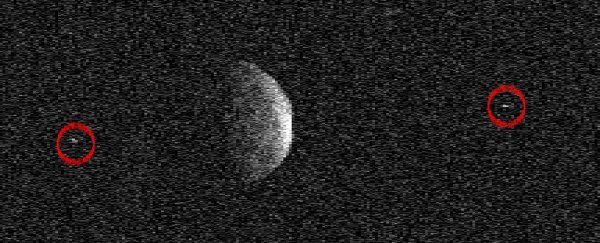Asteroid Florence flew by Earth last week, skimming at a distance of 7 million kilometres (4.4 million miles). It's the biggest asteroid to come this close in more than a century.
It's so big, in fact, that it has two tiny moons of its very own, according to radar images obtained by NASA when Florence was at its closest on 31 August and 1 September.
"While many known asteroids have passed by closer to Earth than Florence … all of those were estimated to be smaller," said JPL-NASA's Paul Chodas, manager of the Center for Near-Earth Object Studies.
"Florence is the largest asteroid to pass by our planet this close since the NASA program to detect and track near-Earth asteroids began."
So how big is big enough to have moons? Florence is just 4.4 kilometres (2.7 miles) across. The moons themselves truly are tiny, between 100-300 metres (300-1,000 feet) across, with orbits of around eight hours for the inner moon and between 22 and 27 hours for the outer moon.
It's actually not unusual for asteroids to have moons. Around 60 near-Earth asteroids of the roughly 16,400 known have at least one moon.
Triple asteroids, which have two moons, are more rare. Florence is only the third near-Earth triple asteroid found to date. The others are Asteroid 1994 CC, discovered to have moons in 2009, and Asteroid 2001 SN263, discovered to have moons in 2008.
Neither of those flew as close by as Florence, however, which offered a rare opportunity to observe the objects in closer detail before it continued on its journey around the sun.
As well as revealing Florence's moons, the new NASA radar images provided a little more information about Florence itself. It's roughly round, but with a ridge along its equator and at least one large crater.
Florence may have continued on its merry way, but NASA will continue to take radar observations for another day or two to make the most of the asteroid's rare proximity.
The last time Florence was this close to the Earth was in 1890, and it won't approach so near again until after the year 2500.
